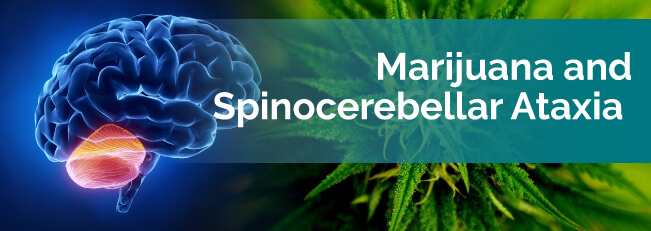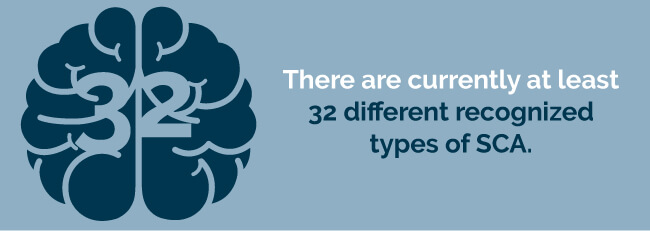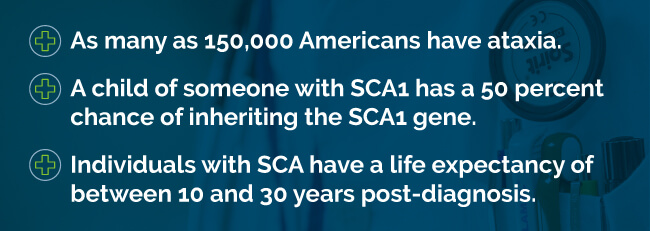
Receiving a diagnosis of spinocerebellar ataxia can be bewildering. You may not have heard a great deal about the condition. You may be understandably worried about your future and what this disease will mean for your quality of life.
In this article, we look at what spinocerebellar ataxia is, its symptoms, treatment options and more. You’ll also discover how medical marijuana for spinocerebellar ataxia helps those who suffer from it improve the quality of their lives.
Spinocerebellar ataxia, also known as SCA, is the name for a group of degenerative and progressive diseases. SCA causes problems with your movements. There are multiple subtypes of the disease. Each of these involves the degeneration of your cerebellum, resulting in loss of muscle coordination. With this in mind, here we’re focusing on the general ways the disease can affect you.
The cerebellum, the area of the brain that controls coordination, is highly compromised as SCA can cause the cerebellum to become smaller or atrophied. Because there are so many types of SCA, people can be misdiagnosed for years. In many cases, those with Ataxia have inherited it. Symptoms associated with spinocerebellar ataxia include poor coordination of hands, eye movements and speech. Additionally, muscle movements are particularly strained. Generally, full mental cognition is preserved. However, physical deterioration may occur over time.
Most cases of SCA are hereditary, and the condition can affect you at any age. If your physician suspects you might have spinocerebellar ataxia, they will recommend you visit a neurologist. Your neurologist will schedule you for a spine and brain MRI and possibly a spinal tap to diagnose the condition.
There are currently at least 32 different recognized types of SCA. Here we look at the history of five of the most prevalent forms, according to the University of Minnesota’s Ataxia Center. The forms are numbered in the order of their chronological discovery.

This type was first found in 1993 in two families from Texas and Minnesota. Symptoms tend to develop in the mid-30s but have been known to begin later in life and in childhood. You’ll initially experience problems with coordinating your hand movements and walking if you have SCA1.
Also known as Cuban ataxia, because the first families presenting with SCA 2 hailed from Cuba, SCA2 is the second-most-dominant form of ataxia. If you have this type, you may find your eye movements are paralyzed, and your movements are slow. You could also suffer from memory problems, reduced reflexes or peripheral neuropathy.
This type of spinocerebellar ataxia is more commonly known as Machado-Joseph disease, as it was named after the descendants of William Machado, Portuguese citizens who moved to England, and Antone Joseph, Portuguese sailors who landed in California in 1845. Although it first affected people with Azorean ancestry, this type is found in people of all nationalities and ethnic groups.
SCA3 often resembles Parkinson’s disease as it tends to give you stiff muscles, neuropathy and tremors. You may also suffer from abnormal eye movements and twitching of your tongue or face.
SCA4 was first discovered in a Utah family with Scandinavian roots. It’s also popped up in a large German family since then. SCA4 has a late age of onset. You may experience peripheral neuropathy, speech problems and issues coordinating your arms and legs.
This ataxia was identified in a branch of Abraham Lincoln’s family and is also known as Lincoln’s ataxia. No one knows whether or not the president carried the gene for the disease. SCA5 often presents when you’re young and progresses slowly.
The many different types of SCA each have their own unique indicators. Still, no matter what form of the disease you’re diagnosed with, you can expect the following symptoms:
The onset of the disease depends on the type you suffer from and can begin anytime from childhood to late adulthood.
It’s common to feel a whole host of emotions when you have SCA. You may feel:
You might be frightened of choking and of people staring at you due to your disease. Speak to your doctor if you’re feeling overwhelmed or depressed by your diagnosis. You can receive assistance from a number of sources.
SCA remains a relatively rare disease. It presents in a very small number of people each year:

There is currently no known cure for SCA. The disease progresses and gets worse with time. However, not all types of spinocerebellar ataxia cause the same levels of disability. As a result, there is no cookie cutter approach to treating the disease.
Although there is no current medical treatment designed specifically for spinocerebellar ataxia, there are several options for patients suffering from the condition. Often if the Ataxia develops as a side effect of another condition, doctors will treat the underlying condition first. Because there are so many leading causes of the condition, it is difficult for healthcare professionals to target one specific treatment plan.
If, for example, the condition occurs because of a metabolic deficiency, a specific diet and medications would be optimal for treatment. If it is caused by a vitamin deficiency, vitamin therapy might be considered. Physical therapy is often utilized for the strengthening of muscles and improved coordination as well. Cannabinoid treatment can improve your appetite and curb nausea.
Cannabinoid treatment can also lead to immediate pain relief and can reduce stress caused by the disease, increase the ability to sleep at night, ease associated depression and relax tightened muscles.
Some conventional treatments are as follows:
Research into medical cannabis for spinocerebellar ataxia remains in its infancy. But there are many indications cannabis can help. Studies have shown marijuana has neuroprotective effects. This finding suggests pot could limit the progression of the disease. Also, cannabinoids protect the brains of Alzheimer’s patients by reducing inflammation, among other issues, which could assist SCA patients. Startlingly, cannabinoids also enhance the birth of new cells.
The following may help you make an informed decision if you’re interested in how marijuana can help relieve your spinocerebellar ataxia symptoms. Pot is known for treating:

To date, Illinois is the only state to approve spinocerebellar ataxia as a qualified condition for the use of medical marijuana. However, many other states have approved cannabis for the treatment of symptoms, such as muscle spasms and chronic pain, commonly associated with spinocerebellar ataxia. Other states, upon recommendation from a physician, will consider allowing medical marijuana to treat the symptoms of spinocerebellar ataxia.
There are many different strains of medical cannabis for spinocerebellar ataxia reflex available to purchase from dispensaries. Each has its unique qualities and effects. It’s a good idea to speak with your medical marijuana doctor or a knowledgeable budtender with regard to what’s best for you. Before you do that, you can take a look at this short list for background information.
Your appetite is often first to suffer when you’re chronically ill. Drugs and medications can also play havoc with your eating. Spinocerebellar ataxia sufferers with little or no appetites may benefit from these strains:
Strains high in limonene elevate your mood. You can tell your pot has a good limonene content by its sweet and citrusy aroma. Of course, asking your budtender for help is another way of seeking out a mood-enhancing strain. You can also ask at your dispensary about cannabis and spinocerebellar ataxia reflex dystrophy and how to best treat it.

A few helpful strains include:
Chronic pain is difficult to manage. Painkillers and medications often give you unpleasant reactions, too. You may wonder if taking them is even worth it due to the side effects you may suffer. Pot is a natural way to manage your pain rather than putting chemicals into your body. These three strains, in particular, may work for you:
Spasticity is an often-upsetting symptom of SCA. You may find your muscles are stiff or tight and you cannot control them. Your reflexes may go on for too long and be particularly strong. You might experience an involuntarily clenched and tight fist, for example. These strains of pot can be a positive and natural choice to help relieve this symptom:
You often suffer from insomnia due to pain and other issues when you’re chronically ill. You spend your nights tossing and turning. Your days are even worse. When you’re irritable and exhausted, trying to cope with the strains and pressures of everyday life is almost impossible. Perhaps this is why people turn to their local medical marijuana dispensary for some natural help, in the form of these strains:
If you feel conventional treatments are just not working for you or you just need something more to help combat SCA, cannabis is well worth a try due to its myriad of positive effects on your condition.
You may wonder how exactly to consume medical cannabis when you’re considering taking it for your spinocerebellar ataxia. There are various ways, which include:
Considering so many ways of taking medical marijuana exist, you undoubtedly will find a method that suits you. If you worry about the stigma of smoking a joint, you needn’t worry as these other methods work just as well.
If you or someone you love is searching for a way to relieve the pain and symptoms of spinocerebellar ataxia, it’s time to take that next step. Medical marijuana may be the solution you’ve been looking for to relieve your spinocerebellar ataxia symptoms and improve your quality of life. Search for a medical marijuana doctor or dispensary today. Take back control of your health and well-being while living with spinocerebellar ataxia.
Find A Doctor Find A Dispensary